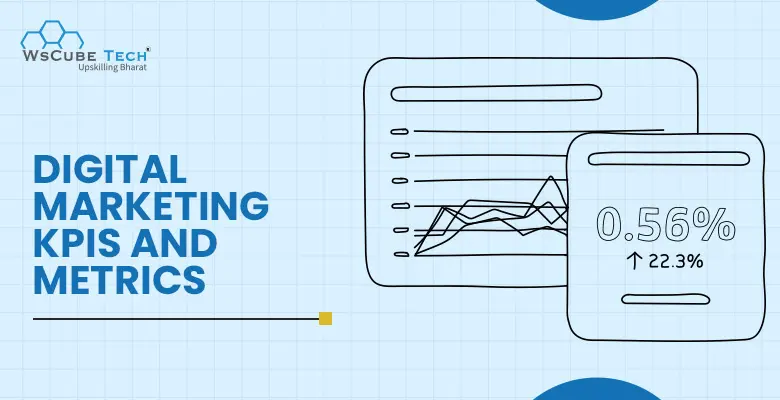You have designed a powerful digital marketing campaign that covers all online channels and has the potential to reach maximum users. However, if you cannot track results and monitor your marketing efforts, how will you know if your strategy is working?
Therefore, marketers and businesses use Key Performance Indicators (KPIs) to measure the results and metrics that matter most to a business’s growth and scaling.
A digital marketing KPI allows companies to reach their goals through measurement. It enables them to monitor progress in terms of quality and quantity. KPIs indicate the level of performance of each action so marketers can get a better perspective of what output their efforts are generating.
Based on different marketing channels and platforms, there are multiple KPIs to detect conversions, revenue, engagement, and other aspects. Marketers use these KPIs to track the activities of their teams.
Keeping an eye on KPIs is not an option but a daily obligation in a marketing routine. In this blog, we will discuss key performance indicators for digital marketing based on different advertising channels.

What Are KPIs in Digital Marketing?
Digital marketing KPIs are quantifiable metrics used to measure the performance of marketing campaigns. They work as a baseline to gauge different aspects of marketing activities and assess how efficiently a company achieves its goals.
These KPIs can be digital or non-digital. They are generally represented in numbers and refer to any aspect of business, such as productivity, financial structure, consumer behavior, employee performance, or sales.
Using KPIs, marketers can design improved future strategies. Hence, finding the right KPIs to measure marketing performance from the beginning is essential. They must prioritize the most effective areas and indicators while tracking metrics. Although learning about all the KPIs can be challenging, our best online digital marketing course will help you understand the primary metrics required to track the performance of marketing campaigns.
Upskill Yourself With Live Training (Book Free Class)
Why Track Digital Marketing KPIs?
Using KPIs for digital marketing enables us to:
- Optimize our marketing budget and direct spending toward marketing channels that generate maximum ROI.
- Find the marketing efforts and tactics that meet expectations
- Identify weak or underperforming campaigns and make necessary improvements
- Get data-driven insights to make informed decisions.
Also Read: What is 360° Digital Marketing? Full Strategy in 2025
Top Digital Marketing Key Performance Indicators to Track
KPIs in digital marketing can vary based on marketing channel or method. Here are the most important KPIs to track and measure:
- Marketing KPIs
- Search Engine Optimization KPIs
- Social Media KPIs
- Email Marketing KPIs
- Paid Marketing KPIs
1. Marketing KPIs
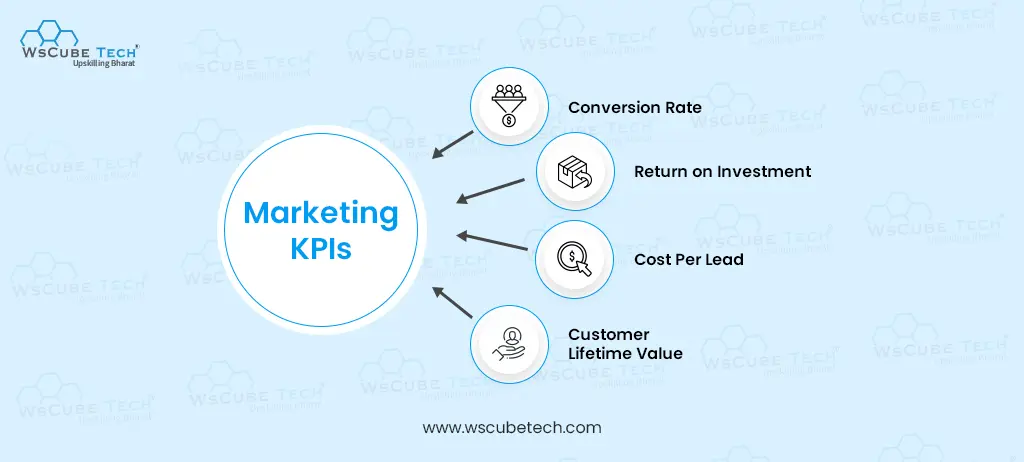
a) Conversion Rate
Conversion rate is the percentage of users that have taken the desired action, such as submitting a form, buying a product, signing up for the newsletter, or installing an app, after interacting with the content or ads.
The desired action can be any step you want your target users to take. Conversion rate is a crucial KPI for businesses to understand how much traffic turns into leads and how many leads turn into buyers, which will increase revenue. By tracking conversion rates, marketers can assess which CTAs, messages, or page designs are most effective and drive better results.
The formula to calculate the conversion rate is:

b) Return on Investment
Return on investment (ROI) is the queen of digital marketing KPIs. It calculates the amount of money a marketing campaign generates against the money invested. ROI is the performance metric marketers use to analyze the efficiency of the money invested in a specific marketing strategy.
We can calculate ROI for almost every process, which must be above 100%. A positive ROI shows that the marketing campaign has performed well, contributing to the bottom line. It’s essential to set a benchmark for each case while calculating ROI.
Below, we have shared the formula to calculate ROI for a marketing campaign:

c) Cost Per Lead
Cost per lead (CPL) is a metric that indicates the amount paid to earn each lead from a marketing campaign. It helps businesses understand how much money they have spent on marketing to get new leads.
We can track CPL across various campaigns and channels. CPL allows us to determine which activities generate more leads at the lowest cost. Hence, we can assess if the amount invested in a campaign is worth the leads generated from it. We can evaluate the resources and time spent on a strategy within a specific period.
We can calculate CPL by using the following formula:

d) Customer Lifetime Value
Customer Lifetime Value (CLV) is among the important digital marketing metrics to find the total revenue a business can possibly earn from a customer throughout their engagement and relationship. CLV can either be historical, which means total profit from the purchases a buyer has made, or predictive, which signifies the expected revenue from a customer.
This KPI helps marketers and businesses guide their marketing efforts in the right direction and make informed decisions regarding customer retention, acquisition, and loyalty programs. This will allow them to nurture and establish long-term customer relationships, leading to sustainable business growth.
CLV must be higher than the amount spent on marketing and sales to acquire one customer. This is a great method for brand owners and marketers to better understand the business.
You can calculate CLV by using the following formula:

Also Read: Artificial Intelligence (AI) in Digital Marketing: The Ultimate Guide
2. Search Engine Optimization KPIs
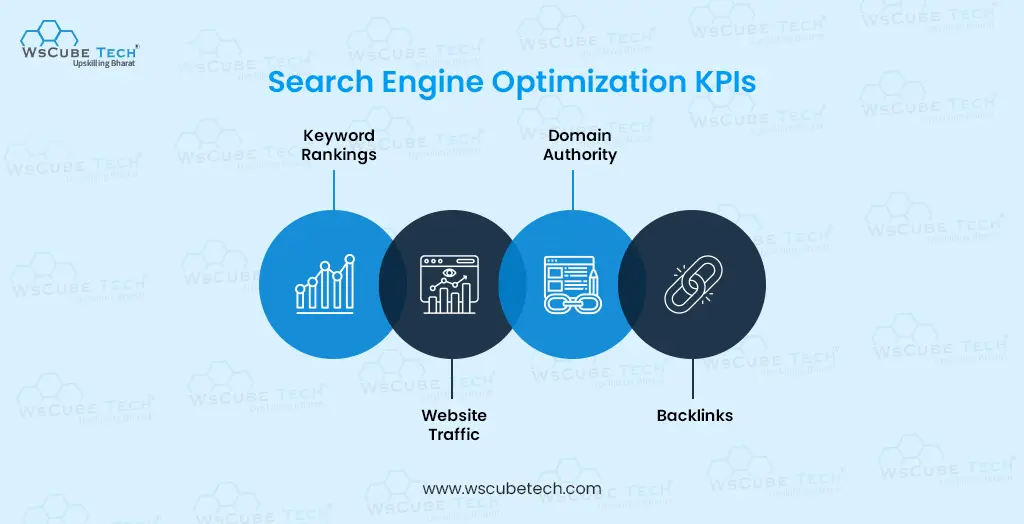
a) Keyword Rankings
Keyword ranking tells you where your website or page stands in search engine results. It helps you track your website’s position for a specific keyword.
Your website ranking may change over time, and you can track this shift to find what works and what doesn’t. You can get more organic traffic and leads with improved search engine rankings.
One page can rank for multiple keywords, and the top five search results get the most clicks by users. Hence, make sure to regularly track your keyword rankings and improve your SEO efforts to drive higher traffic.
b) Domain Authority
Moz gets all the credit for introducing domain authority, one of the most important digital marketing KPIs that measures the overall authority and trustworthiness search engines attribute to a website.
It shows if search engines find your content useful and valuable. Page authority is also the same, but it is measured on a page-by-page basis. A higher domain authority score means better search engine rankings.
c) Website Traffic
Website search traffic means the total number of visitors arriving on your site through unpaid search results. The traffic on your website shows its relevance and visibility in SERPs.
Search traffic is among the top KPIs for digital marketing that includes several metrics, such as organic traffic, total visits, page views per session, unique visitors, traffic source, site visitors, top web pages, and more KPIs associated with the traffic your website gets from search engines.
d) Backlinks
Quality backlinks are endorsement of a website. Hence, they are considered a vital search engine ranking factor, especially the ones websites get from high authority and reputable websites. That is why marketers invest a lot of time and energy in building optimized and relevant backlinks.
Using this KPI, you can track the number of websites linked to yours and assess how these links influence your website traffic and rankings in SERPs.
When you build quality and relevant links from top websites, Google treats your website as more authoritative and credible, which translates into higher rankings and more organic traffic.
Interview Questions for You to Prepare for Jobs
| Digital Marketing Interview Questions | SEO Interview Questions |
| Email Marketing Interview Questions | Content Writing Interview Questions |
3. Social Media KPIs
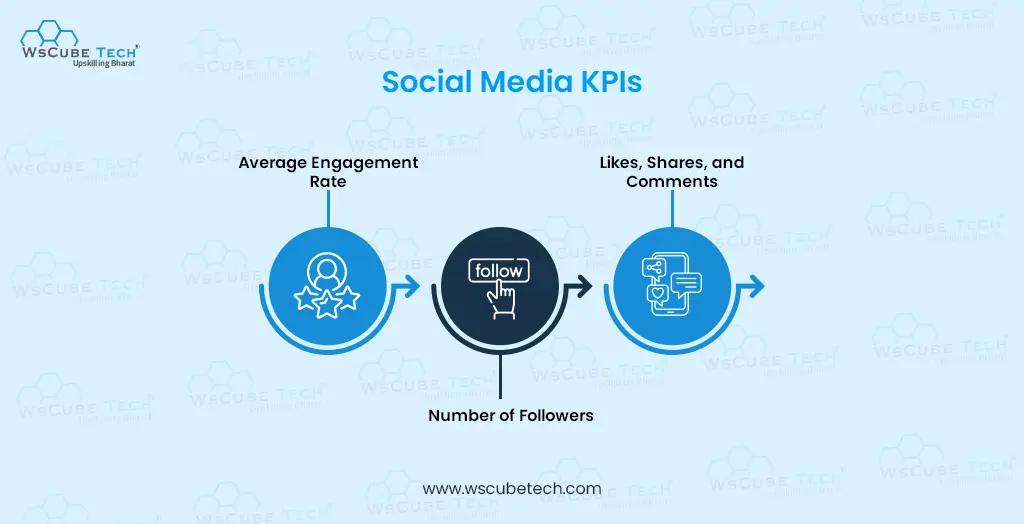
a) Average Engagement Rate
The average engagement rate (AER) refers to the percentage of people who liked, shared, or commented on your social media posts compared to the number of followers. It also includes saved content. You can find out the average engagement rate by dividing the total number of engagements received by the total number of posts within a specific period. Divide the answer by total followers and multiply it by 100.
Here is the formula to calculate AER:

b) Number of Followers
Follower count signifies the total number of users following your social media page or profile on different platforms. It is a social proof used to gauge the popularity of your brand and helps you know the number of people who can potentially see your posts and content.
Big brands regularly create innovative and unique content for their social media profiles to engage users and increase followers. However, a larger follower count doesn’t ensure that every follower sees your posts.
Also Read: Digital Marketing Process 2025: Step By Step Guide
c) Likes, Shares, and Comments
Likes, shares, and comments are like the lifeline of social media sites and posts. Hence, it is a crucial part of every digital marketing KPIs list.
If social media is one of the key marketing channels for your brand, you need to post engaging content and get more exposure on various platforms.
4. Email Marketing KPIs
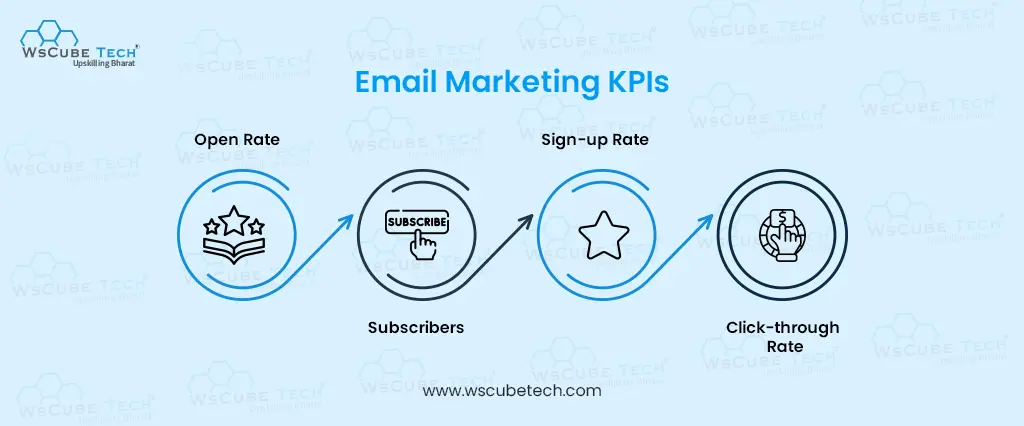
a) Open Rate
The open rate shows the percentage of recipients on your email list who open your emails compared to the number of emails sent. This is an excellent KPI to assess the effectiveness of your email campaigns and evaluate their engagement and relevancy.
Monitor open rates regularly to see how different subject lines perform and influence people. For example, you may notice that shorter or quirkier subject lines are more compelling than others.
If you witness the open rate going down, revamp your email marketing campaign and craft more attractive subject lines. Subject lines that resonate with the audience will lead to higher open rates. Try adding different subject lines for various sections of the audience to increase open rates.
b) Subscribers
Subscribers are the total number of users who have opted to receive your emails. You can use a reliable email marketing platform to track the number of subscribers.
It is a crucial KPI as it indicates the size of the audience your brand can reach through your emails. With time and through effective email marketing campaigns, you can nurture subscribers, build a loyal connection, and convert them into leads. There are several ways to increase subscribers, such as offering discounts, sharing valuable information, and updating about the latest products.
Once users subscribe to your newsletter, consistently provide useful information to keep them engaged with your brand; otherwise, they can unsubscribe.
Unsubscribe is also one of the digital marketing KPIs examples used to track the number of people who have unsubscribed to your newsletter.

c) Sign-up Rate
The sign-up rate is the percentage of people who visit your website and sign up for your email list. It can be for white papers, newsletters, case studies, blogs, etc.
d) Click-through Rate
The click-through rate (CTR) is the ratio of the total number of people who click on a link in your email to the number of email recipients who have opened the email. It is one of the key digital marketing KPIs, showing how many users engage with your emails and are interested in learning more about your brand, product, or offerings.
When you include a page or product link in your email, you can easily track the number of people who click on it.
Always set CTR expectations according to industry standards. For example, the average CTR in the e-commerce industry is 2.01%. So, if a company in this industry achieves a CTR above this, it is likely to perform well.
One proven way to increase CTR is to write engaging and informative email content. Be accurate, get to the point fast, convey your message directly, and add strong visuals. Your tone must align with the brand voice and be consistent.
Also Read: What Does a Digital Marketer Do? Work, Roles, Responsibilities
5. Paid Marketing KPIs
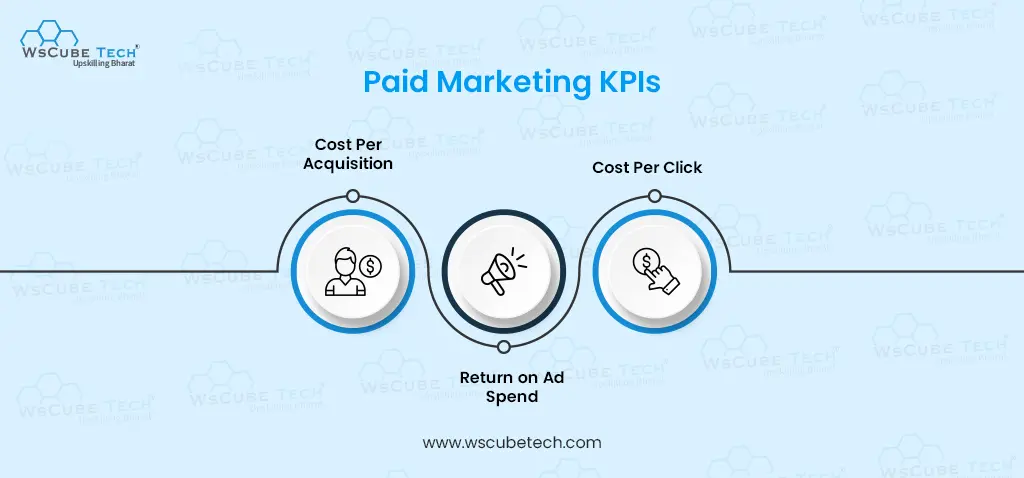
a) Cost Per Acquisition
Cost per acquisition (CPA) is the total marketing spend to acquire a buyer on a specific marketing channel. It includes all the costs incurred to convert a user into a paying customer, including software, tools, salaries, and other resources and overhead.
The aim of calculating CPA is to know if ads are making profits or not. A profitable ad will have lower CPS than the customer lifetime value. On the other hand, a growing CPS means your paid ads are not effective enough.
A few useful ways to lower CPA are by optimizing conversion rates through improved landing page designs and content, creating more targeted ads, and adding attractive visuals. Also, track CPA for each channel individually for deeper insights, as you might find that social media ad campaigns are much cheaper than Google Ads or vice-versa. This will help you allocate your PPC budget wisely.
Here is the formula to calculate CPA for a given period for a specific ad campaign.

b) Return on Ad Spend
Return on ad spend is the revenue earned from a paid ad compared to the amount spent across multiple channels over a period. It is a critical digital marketing metric to measure the performance of an ad and get a clearer picture of how well your allocated budget translates into revenue.
Return on ad spend shows the revenue a business has earned for every penny it spent on paid ads. Marketers use it for every digital marketing paid ad campaign and find the most result-driven campaigns.
Calculating return on ad spend is quite simple. You simply have to divide the revenue generated from the ad by the total money spent.

c) Cost Per Click
Cost per click (CPC) is another digital marketing KPI that shows the total amount paid for every click on your ad. It measures the profitability and cost-effectiveness of your online paid advertising campaigns.
The formula to calculate CPC is:

Conclusion
The metrics and KPIs listed above are just the beginning of measuring marketing efforts. There are plenty of other digital marketing metrics businesses have to take care of.
So, get acquainted with the essential KPIs that will help you identify growth areas, assess your marketing efficiency, and increase ROI. To get an in-depth understanding of digital marketing KPIs and how to track them, sign up for our digital marketing course now.
Read more blogs:



